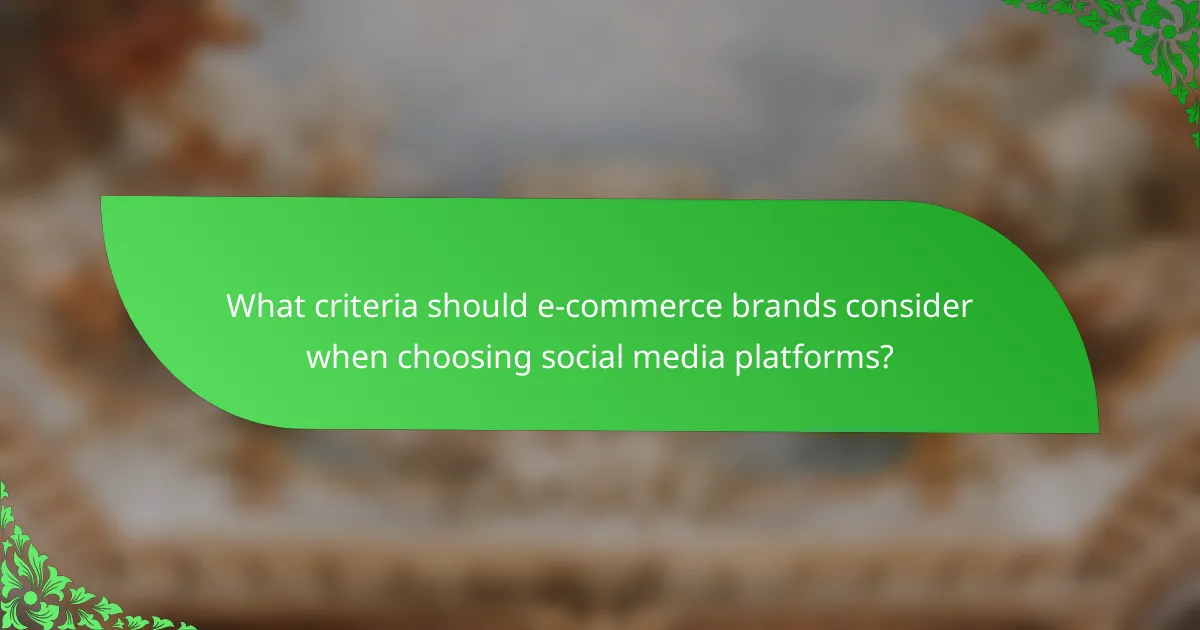Social media has become a vital tool for e-commerce, with platforms like Facebook, Instagram, Pinterest, Twitter, and LinkedIn offering unique features that enhance online shopping experiences. By developing targeted strategies that include engaging content and analytics, brands can significantly boost their visibility and sales. Additionally, fostering meaningful interactions with audiences through timely responses and interactive events is essential for building loyalty and community around a brand.

Which social media platforms are most effective for e-commerce?
The most effective social media platforms for e-commerce include Facebook, Instagram, Pinterest, Twitter, and LinkedIn. Each platform offers unique features that cater to different aspects of online shopping, from targeted advertising to visual engagement.
Facebook for targeted advertising
Facebook is a powerful tool for targeted advertising, allowing businesses to reach specific demographics based on interests, behaviors, and location. Advertisers can create custom audiences and utilize retargeting strategies to engage users who have previously interacted with their brand.
To maximize effectiveness, consider using Facebook’s dynamic ads, which automatically show relevant products to users based on their browsing behavior. This approach can significantly increase conversion rates and drive sales.
Instagram for visual engagement
Instagram excels in visual engagement, making it ideal for brands that rely on aesthetics to attract customers. High-quality images and videos can showcase products effectively, and features like Stories and Shopping Tags enhance the shopping experience.
Utilizing influencers on Instagram can also amplify reach and credibility. Collaborating with influencers who align with your brand can lead to authentic engagement and drive traffic to your e-commerce site.
Pinterest for product discovery
Pinterest serves as a visual discovery platform, where users actively seek inspiration for purchases. It is particularly effective for lifestyle and home goods, as users often use the platform to plan future purchases.
To leverage Pinterest, create visually appealing pins that link directly to product pages. Using keywords in pin descriptions can improve visibility in search results, making it easier for potential customers to find your products.
Twitter for customer service
Twitter is an effective platform for customer service, allowing businesses to engage with customers in real-time. Quick responses to inquiries can enhance customer satisfaction and build brand loyalty.
To optimize your Twitter presence, monitor mentions and direct messages regularly. Establishing a dedicated customer service handle can also streamline communication and improve response times.
LinkedIn for B2B marketing
LinkedIn is the premier platform for B2B marketing, making it suitable for companies targeting other businesses. It offers opportunities for networking, lead generation, and sharing industry insights.
To succeed on LinkedIn, share valuable content that addresses industry challenges and showcases your expertise. Engaging with relevant groups and participating in discussions can also help establish authority and attract potential clients.

How can e-commerce brands develop effective social media strategies?
E-commerce brands can develop effective social media strategies by clearly defining their target audience, creating engaging content, utilizing analytics for optimization, and implementing influencer partnerships. These components work together to enhance brand visibility and drive sales through social platforms.
Define target audience
Identifying the target audience is crucial for tailoring social media strategies. Brands should consider demographics such as age, gender, location, and interests to create content that resonates with their potential customers.
Utilizing tools like Facebook Audience Insights or Google Analytics can help gather data on existing customers, allowing brands to refine their audience profiles. Regularly revisiting these profiles ensures that marketing efforts remain aligned with evolving consumer preferences.
Create engaging content
Engaging content is essential for capturing attention on social media. Brands should focus on high-quality visuals, storytelling, and interactive elements like polls or quizzes to encourage user participation.
Content should be varied, including promotional posts, behind-the-scenes looks, and user-generated content. A good rule of thumb is to maintain a balance between promotional and non-promotional posts, often following the 80/20 rule where 80% is value-driven content and 20% is promotional.
Utilize analytics for optimization
Analytics play a vital role in optimizing social media strategies. Brands should regularly review metrics such as engagement rates, click-through rates, and conversion rates to assess the effectiveness of their content.
Using tools like Google Analytics or social media insights can help identify which types of content perform best. Brands should be prepared to adjust their strategies based on these insights to improve overall performance and reach.
Implement influencer partnerships
Partnering with influencers can significantly boost a brand’s visibility and credibility. Brands should seek influencers whose audience aligns with their target market to ensure authentic engagement.
When selecting influencers, consider their engagement rates and the authenticity of their content. Collaborations can range from sponsored posts to product reviews, and brands should establish clear expectations and goals for each partnership to maximize effectiveness.

What are the best practices for social media engagement?
Effective social media engagement involves actively interacting with your audience to build relationships and foster loyalty. Best practices include timely responses, encouraging content creation from users, and hosting interactive events that captivate your followers.
Respond promptly to customer inquiries
Timely responses to customer inquiries are crucial for maintaining engagement on social media. Aim to reply within a few hours, as delays can lead to frustration and lost opportunities. Utilize automated responses for common questions to ensure no inquiry goes unanswered.
Consider setting up alerts for messages and comments to stay on top of inquiries. This proactive approach not only enhances customer satisfaction but also demonstrates that you value your audience’s input.
Encourage user-generated content
User-generated content (UGC) can significantly boost engagement and authenticity. Encourage your followers to share their experiences with your brand by creating specific hashtags or running campaigns that invite submissions. This not only provides you with valuable content but also fosters a sense of community.
Highlighting UGC on your own channels can motivate others to participate. For example, feature customer photos or testimonials on your profile, which can lead to increased visibility and trust among potential customers.
Host interactive events or contests
Interactive events and contests are effective ways to engage your audience and create buzz around your brand. Consider hosting live Q&A sessions, webinars, or contests that encourage participation, such as photo challenges or giveaways. These activities can drive traffic and increase follower interaction.
Make sure to promote these events across your social media platforms and provide clear instructions on how to participate. Offering attractive prizes can further incentivize engagement, leading to higher participation rates and greater brand exposure.

How can e-commerce businesses measure social media success?
E-commerce businesses can measure social media success through various metrics that reflect engagement, conversion, and brand perception. By focusing on key performance indicators (KPIs), companies can gain insights into their social media effectiveness and make data-driven decisions to enhance their strategies.
Track engagement metrics
Engagement metrics such as likes, shares, comments, and follower growth are essential for assessing social media performance. These indicators show how well content resonates with the audience and can guide future content creation. For instance, a post with high engagement may suggest a successful topic or format that can be replicated.
To effectively track engagement, utilize analytics tools provided by social media platforms or third-party services. Regularly review these metrics to identify trends and adjust your strategy accordingly. Aim for a consistent increase in engagement over time, as this often correlates with brand loyalty and customer retention.
Analyze conversion rates
Conversion rates measure the percentage of social media interactions that lead to desired actions, such as purchases or sign-ups. By analyzing these rates, e-commerce businesses can determine how effectively their social media efforts drive sales. A typical conversion rate for e-commerce can range from 1% to 5%, depending on the industry and audience.
To analyze conversion rates, set up tracking links or use UTM parameters to attribute sales to specific social media campaigns. Regularly assess which platforms and content types yield the highest conversion rates, allowing for more targeted marketing efforts. Avoid focusing solely on traffic; prioritize quality leads that are more likely to convert.
Monitor brand sentiment
Brand sentiment refers to the public’s perception of a brand based on social media interactions. Monitoring sentiment helps e-commerce businesses understand how their audience feels about their products and services. Tools that analyze sentiment can categorize mentions as positive, negative, or neutral, providing valuable insights into customer opinions.
To effectively monitor brand sentiment, utilize social listening tools to track mentions across platforms. Regularly review feedback and comments to identify areas for improvement or potential crises. Responding promptly to negative sentiment can mitigate damage and demonstrate a commitment to customer satisfaction.

What criteria should e-commerce brands consider when choosing social media platforms?
E-commerce brands should evaluate social media platforms based on their target audience, the types of content they plan to share, and the advertising features available. Selecting the right platform can enhance engagement and drive sales effectively.
Audience demographics
Understanding audience demographics is crucial for e-commerce brands when selecting social media platforms. Each platform attracts different age groups, interests, and behaviors. For instance, Instagram and TikTok are popular among younger users, while Facebook has a broader age range, including older demographics.
Brands should analyze their target market to identify where their potential customers spend their time online. Tools like audience insights on social media can provide valuable data about user characteristics and preferences.
Content type compatibility
Different social media platforms support various types of content, which can influence a brand’s choice. For example, Instagram is highly visual, making it ideal for brands that rely on images and videos, while Twitter is better suited for concise text updates and real-time engagement.
Brands should consider their content strategy and the formats they excel in, such as videos, infographics, or blog posts. Aligning content types with platform strengths can enhance visibility and engagement.
Advertising capabilities
The advertising capabilities of social media platforms are essential for e-commerce brands looking to reach a larger audience. Platforms like Facebook and Instagram offer advanced targeting options, allowing brands to reach specific demographics based on interests, behaviors, and location.
Brands should evaluate the cost-effectiveness of advertising on each platform, considering factors like click-through rates and conversion rates. Testing different ad formats and analyzing performance metrics can help optimize advertising strategies for better ROI.

What are the emerging trends in social media for e-commerce?
Emerging trends in social media for e-commerce include the rise of live shopping, increased use of augmented reality (AR), and the growing importance of social commerce. These trends are reshaping how brands engage with consumers, making shopping more interactive and personalized.
Live Shopping
Live shopping combines real-time video streaming with e-commerce, allowing brands to showcase products while interacting with viewers. This trend has gained traction as it creates a sense of urgency and excitement, often leading to higher conversion rates. Brands can host live events on platforms like Instagram and Facebook, where viewers can purchase items directly during the stream.
To effectively implement live shopping, brands should focus on engaging hosts, interactive content, and limited-time offers. It’s essential to promote the event in advance to build anticipation and ensure a larger audience. Common pitfalls include poor production quality and lack of clear calls to action.
Augmented Reality (AR)
Augmented reality enhances the shopping experience by allowing consumers to visualize products in their own environment before making a purchase. This technology is particularly popular in industries like fashion and home decor, where seeing the product in context can significantly influence buying decisions.
Brands can utilize AR features on platforms like Snapchat and Instagram to create immersive experiences. For example, a furniture retailer might allow customers to see how a couch fits in their living room. It’s crucial to ensure that the AR experience is user-friendly and adds real value to the shopping process.
Social Commerce
Social commerce refers to the integration of e-commerce functionality directly into social media platforms, enabling users to buy products without leaving the app. This trend simplifies the shopping journey, making it more convenient for consumers to discover and purchase products.
Platforms like Facebook Shops and Instagram Shopping are leading the way in social commerce. Brands should optimize their social media profiles to showcase products effectively and utilize features like shoppable posts and stories. A common mistake is neglecting to update product information, which can lead to customer frustration and lost sales.
